|
|
| 'Like' us on Facebook | Follow us: |
Posted on: June 15, 2014
SUMMER COURSE TALKS
Since the year 2012, the Sri Sathya Sai Institute of Higher Learning has been conducting a 2-3 day Summer Course in Indian Culture and Spirituality for the Students of the University. This Summer Course, though shorter in duration compared to the fifteen days long summer course organized by Bhagawan, is designed and structured along similar lines. Bhagawan used to organize the Summer Course in Indian Culture and Spirituality first in the 1970s which was open to all youth across the country (including at times some overseas participants too) and later in the 1990s which was exclusively for the students of the University. The main objective of the Course was to give students a strong spiritual foundation, which is achieved in part through lectures delivered by learned scholars, senior devotees and men and women of esteem. The highlight was the daily discourse by Swami, delivered typically in the evening.
The Summer Course for the academic year 2012-13 was held from 8 to 9 June 2012 in Prasanthi Nilayam. As part of this Summer Course few of the young members of the faculty and research scholars gave inspiring and erudite talks on epics like the Ramayana and Mahabharata, scriptures like the Vedas and Upanishads, and a few esoteric concepts which form the corner stones of the great Bharatiya culture. We had earlier published two talks, 'Law of Karma - A Tenet of Indian Philosophy' and 'Ramayana - The Key to be Near and Dear to God.' We now bring you another talk delivered during that Summer Course, even as this year's Summer Course is underway. The Radio Sai Team is grateful to the SSSIHL for permitting us to share with our readers these transcripts.
Lessons for Life from the Upanishads
Dr. N Siva Kumar
Dr. Sivakumar joined for his PUC programme in the erstwhile Sri Sathya Sai Arts and Science college, Brindavan, way back in the year 1982. He then went on to complete his B.Com from the Brindavan Campus of the SSSIHL. Later he was part of the second batch of the MBA programme of the University, a degree he completed with a Gold Medal for academic excellence. He also received the prestigious All Rounder gold medal from Bhagawan during the course of his education. He then pursued his doctoral research which he completed in the year 1995, which happens to be the first doctorate to be awarded in the faculty of Management by the University. He still is an active researcher and contributes regularly to international journals in the field of ethics and values in business and management. Currently he serves Bhagawan as an Associate Professor in the Department of Commerce, Brindavan Campus. Apart from his academic credentials, Dr. Sivakumar is a keen student of the Vedas and he incorporates the wisdom from the Vedas and Upanishads in modern-day subjects he teaches to university students. This talk on the Upanishads was delivered in the Poorna Chandra Auditorium on 8 Jun 2012. |
Shivashakte namastubhyam varade Sairoopini
Bhasyarambham karishyami siddhir bhavatume sada
The Upanishads are the last section of the Vedas considered and known as the Vedanta. There are many Upanishads, but ten of them are the principle ones, and commentaries have been written on them by the great Adi Sankara.
Isha kena katha prashna munda mandukya taitiree, aitareyan cha chandogyam bridharanyakam dasha.
These are the ten principal Upanishads, the Brihadaranyaka Upanishad being the longest of these and the Mandukya Upanishad being the shortest. The Father of our nation, Mahatma Gandhi often used to quote the first line of the Ishavasyopanishad. It goes like this:
Om Isavasyam idam sarvam yat kim ca jagatyam jagat
tena tyaktena bhunjitha, ma gridhah kasyasvid dhanam
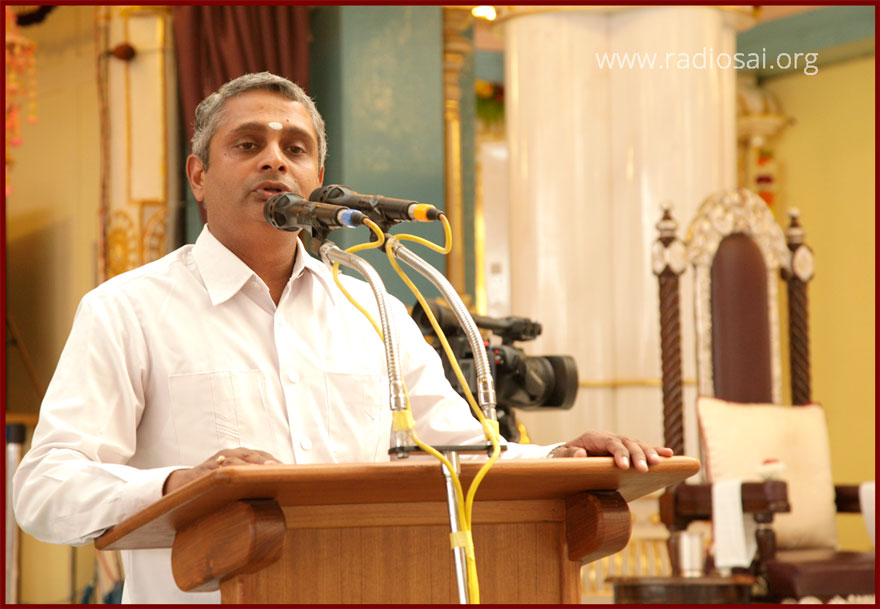 |
|
| Dr. N Sivakumar delivering a talk in the Sai Kulwant Hall, Sep 2013 |
This was chanted by Mahatma Gandhi to develop the principle of trusteeship, meaning accepting whatever is conferred upon us by God and living without any covetousness.
Our institute logo contains the words satyam vada dharmam chara, (Speak the Truth, Act Righteously) which are part of the Taittiriya Upanishad. The Upanishads contain the highest spiritual and moral truths, which all of us can practice in daily life. I would like to elaborate on a few such lessons, not by concentrating on any specific Upanishad, but by dwelling upon the meaning of the word Upanishad itself.
Upanishad is derived by the combination of three words – Upa–Ni– Shad. Upa means near Ni means down and Shad means sit. This means sitting down near the guru or God. I will try to elaborate the meaning of these three words and derive lessons from it as takeaways of this presentation.
Upa means near or living near the guru or living with God for all of us. Swami often used to say that living with God is true education. As the Taittiriya Upanishad says
Bhrugur vai varunehi
varunam pitarmupasasara
adhihi bhagavo brahmeti
tasma etat provacha
Annam pranam chakushusrotram manovacham iti
tagum hovacha
yatho va emani bhutani jayante
Yena jatani jeevante
yatprayantyabhi samvishante
tad vi jignyansasva
tad brahmeti
sa tapo tapyata
sa tapas taptwa
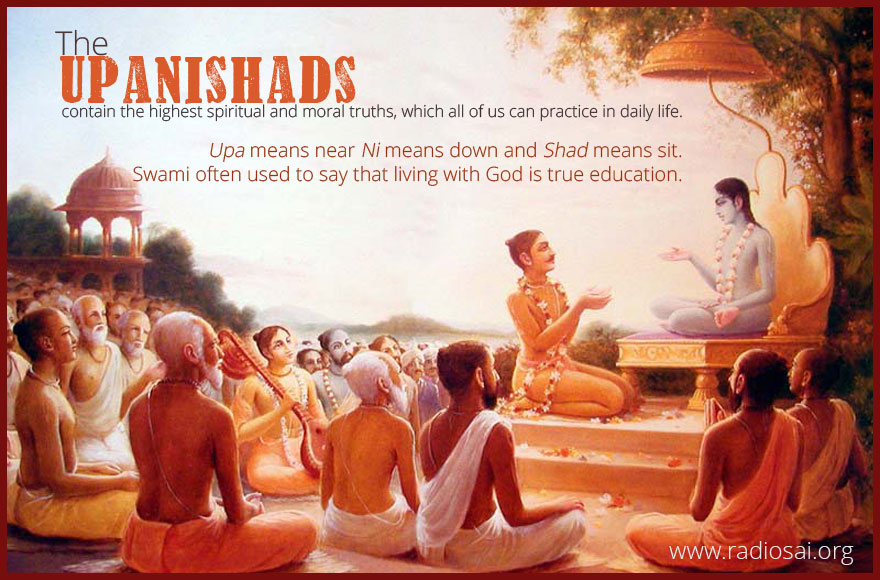 |
Being Near the Guru
Bhrigu learnt the highest truth by being near his guru and his father Varuna. The biggest secrets of life are learnt by being near God or near a great master. Nearness could be either physical or spiritual. We had the great opportunity of being very physically close to Bhagawan.
We were once very near to Bhagawan during a trip to Kodaikanal, since on these trips we live with Bhagawan throughout the stay. I learnt some very interesting lessons on this trip. We spend all the food sessions with Bhagawan and once when we were sitting for lunch, food had been served and Swami wanted us to chant the Brahmarpanam. As I finished chanting the prayer and opened my eyes, I saw Swami intently watching me. I was delighted and at the same time surprised as Swami wanted to convey something serious to me. He said, “Can’t you remain steady and remain fully concentrated in those few moments of chanting Brahmarpanam?” I was stunned, as I didn’t know what I had done. In those few moments accidentally without even my knowledge, I had scratched my nose and my back, which Swami very clearly noticed. He commented, “Be steady when you are chanting the Brahmarpanam because that is the moment when you offer your food to the Lord.” It was a very important lesson I learnt, being physically near to Bhagawan.
During the same Kodaikanal trip I realised that how much concern Bhagawan has towards all of us. We were all sitting for breakfast and Swami enquired about a boy, finding that he is not present. Other students informed Swami that this particular boy was not feeling well and was sleeping in the room. As we were having breakfast, Swami quietly went into the kitchen and got a cup of coffee. Some of us who had finished breakfast slowly followed Swami, as He walked up the stairs into the room where that boy was sleeping. We went ahead of Swami and prodded that student and he got up. He saw Swami coming and as he was about to get up Swami said, “No! No! Just keep lying down and take this coffee, which I have brought for you.” The boy was so happy to see Swami physically coming and taking care of him. He tried to get up to hold the cup of coffee. But Swami, the ocean of mercy, said, “Don’t get up, just raise your head.” We saw how the Lord serves His devotees. Swami kept the cup of coffee near the lips of the boy held it in His hand and asked the boy to just sip the coffee from that cup. This is how Swami teaches us how to serve others and we learnt it from the physical nearness to the Lord.
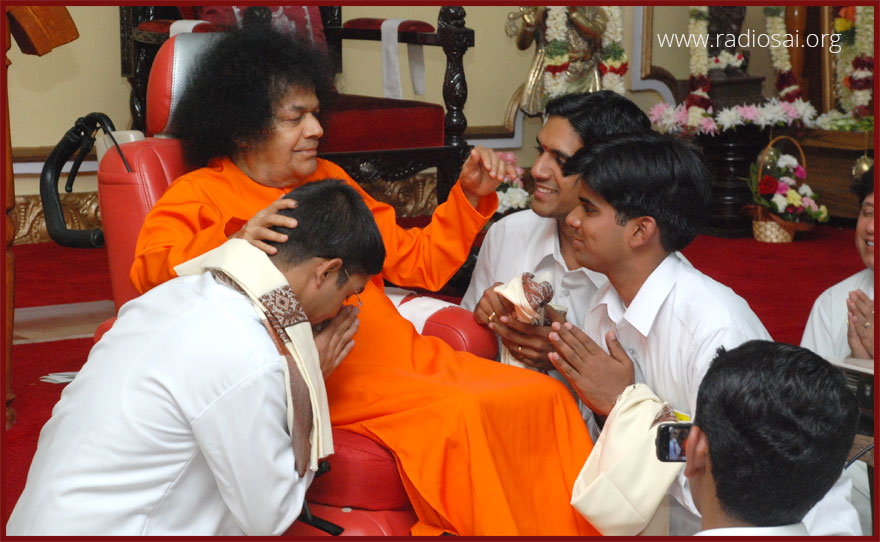 |
On another occasion in Trayee Brindavan, a great scholar Sri G V Subba Rao was speaking about the Purusha suktam. He was elaborating on the following lines:
Deva yad yagnam tanvanaha abadhnan purusham pashum Tam yagnam barihi shi proukshan purusham jata magrataha
The original meaning of this is that in the process of creation, the Purusha Himself was tied to the sacrificial post. As he was finishing, Swami said, “it can be abadham purusham pashum but you can chant it as appadham purusham pashum.” None of us, including the great scholar understood the meaning of ‘appadham’. Swami expounded it in the simplest of ways and said, “appadham purusham pashum means (in Telugu) that the one who speaks lies is a pashu or an animal.” This we all learnt from the physical nearness to the Lord.
Spiritual Nearness is true Nearness
We all know now that we have to replace the physical nearness with spiritual nearness. The Quran states that spiritual nearness endows a person with great realities of the world, that can’t be known by ordinary methods of learning. Here I would like to quote an example of spiritual nearness. This is a story of a person who never studied in the Sai educational institutions, and yet was spiritually close to Swami as we understand. From a very young age he was attracted to Swami and was part of Balvikas, and later on, was a very active member of the service organization. In his state, he was a part of every single service activity that the organization undertook. Everybody knew that this person was an active member and at a later stage he could motivate several people to the path of service. However a tragedy struck and he suffered with an incurable disease and within a short time this person passed away. Everyone was stunned and questioned ‘why Swami didn’t bless this person?’ His body was being taken for cremation and there was a large crowd following the procession. One of the devotees, seeing the huge following, thought of taking pictures, thinking that it will motivate others to follow his example. He took photographs of the final procession. When these photos were shown to others, everyone was able to see in every, single photo of the procession, Swami physically standing. All were so happy to know that this person had spiritual nearness with Swami.
How can we get the spiritual nearness? We can get this spiritual nearness by actively participating in the schedule of the University and ensuring that we do our duty sincerely. The first takeaway of this aspect, Upa, is that let us strive everyday to cultivate this spiritual nearness to Swami. This, over a period will definitely protect us.
The Second Prerequisite for Learning
The second aspect of this word Upanishad is Ni, which means down. Why should this word ‘down’ be stressed so much? We know from Physics that things fall down, water flows down as it is a natural process. The symbolic meaning of ‘Ni’ is humility. If we are humble, knowledge and wisdom will automatically flow to us, just as water flows automatically from a higher plane to a lower plane. Knowledge will effortlessly flow from Him to us if we are humble.
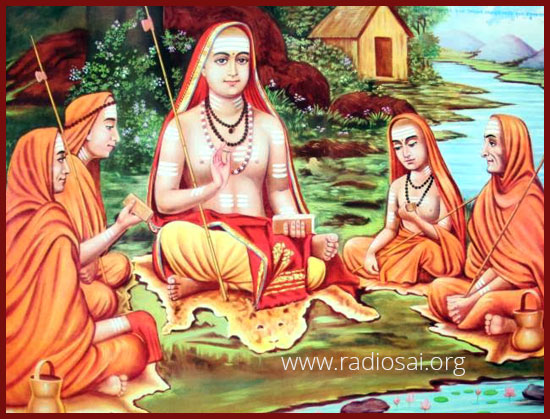 |
To illustrate this, Swami praised a disciple of Adi Sankara by the name of Thotaka. This particular student was not considered initially to be a great scholar. In fact, he was considered by all other students as a dullard. Yet he used to do all the simple jobs assigned by the guru and Thotaka would be ready to serve the guru always in total humility. Swami said that this particular characteristic of humility made Thotaka a great acharya. One particular day as he was washing the clothes of the guru, Adi Sankara beckoned him from far. Thotaka came near Adi Sankara, bowed down to him and immediately started singing great Sanskrit verses, which are popularly known today as the Thotaka astakam. Nobody expected him to compose verses and yet the knowledge shown in Thotaka astakam astounded everyone. People then understood that his humility gave him the wisdom that he deserved.
The modern scientific examination technique of MRI (magnetic resonance imaging) explains the importance of humility. When a person is stress free and humble, the MRI images of the brain show a natural expansion and the brain easily absorbs more knowledge and wisdom. On the other hand when the mind is stressed, the brain contracts and doesn’t absorb additional knowledge. Hence the second takeaway stresses on the virtue of humility. When students enter a class they should start with a feeling of humility and with an attitude of learning a new lesson in class. When we start with this attitude, we will always learn something new when we enter the class and this, over a period of time, will accrue to our knowledge and wisdom. However, if we start with the idea that I already know everything, nothing additional or incremental will accrue to us. This is the second aspect of humility that is greatly stressed in the word Upanishad.
The Virtue of Steadfastness
The final takeaway from this word Upanishad is ‘Shad’ which means sitting. Why is the student asked to sit? Is it just the physical act of sitting or is it something more? The true meaning of the word ‘shad’ is that it represents stability. There is this famous story from the Kathopanishad where Nachiketa sees his father giving away famished cows in charity. Rather surprised, he asks his father, “Father! You are giving away famished cows, it will not give you any result. To whom are you going to give me in charity?” His father thinks that it is a prank and later gets angry and says, “I give you in charity to Lord Yama (God of Death).” Nachiketa takes this literally and goes to Yamapuri. There he is told that Lord Yama has gone out and will return after three days. Nachiketa, as explained by Kathopanishad, stands for three days with utmost steadfastness at the entrance of Yamapuri without any movement and vacillation. Lord Yama is delighted to see this boy and grants him three boons. That is how the entire story of the Kathopanishad unfolds and we are given the secrets of immortality.
In the Bhagavad Gita, Arjuna asks Krishna about the mind: Chancalam hi manah Krishna pramadi balavadrudham, meaning ‘Oh! Krishna, the mind is so fickle. How can it be controlled?' Krishna says in another verse: Abhyasa yogena tato mamicchaptum Dhananjaya; meaning, through practice, the vacillation of this mind can be controlled. The word ‘shad’ represents the control of the vacillation of the mind.
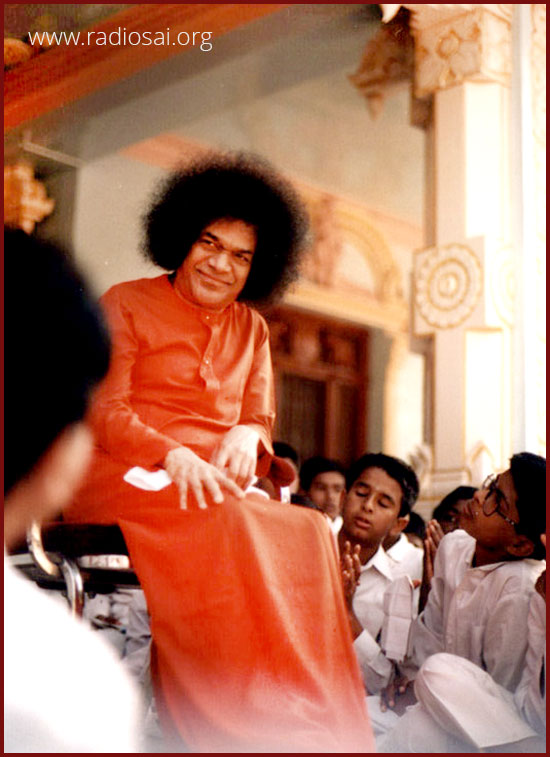 |
Swami gives a very simple technique to get more and more steadfast and inculcate equipoise. Patanjali Yoga Sutras talk of Dharana, Dhyana and Samadhi. Swami said that intense concentration without any vacillation for a period of eleven seconds is one event of Dharana. Eleven such events of Dharana become Dhyana and eleven such Dhyanas will lead one to Samadhi. He said that it is actually a matter of twenty minutes when you can achieve the state of Samadhi. Swami said that for this to happen, the most fundamental prerequisite is steadfastness and equanimity. With this equanimity, we can face every event of life in a very happy way.
Let me narrate to you a very interesting story of a student of Brindavan who contracted jaundice and the doctors told him to take rest and prescribed strict dietary restrictions. Swami was at that time staying in Brindavan. This boy took special permission of the warden to sit in the first row thinking that Swami will bless him and give him Vibhuti prasadam for his disease. This student waited for Swami to come and as soon as Swami came near, he told Swami that he had jaundice. To the astonishment of this boy, Swami said, ‘Be Happy’ and went away. He was surprised because he wanted prasadam and all Swami said was: Be happy. Later he analysed the statement of Swami of asking him to be happy. He thought of two different possibilities. The first was where he would be unhappy because, of all the boys in the hostel, he got this disease; and the second possibility where he would accept this as Swami’s blessing thinking that even with this disease Swami wants him to be happy. He thought to himself, “Let me remain happy, let me take the medicines and proper food; anyway the jaundice will be cured in one month.” With either of the attitudes, the jaundice would get cured, but the mental state would be different. In the first case, the student would always be unhappy and in the second case he would always be happy. Swami wanted this boy to understand this idea of always being happy. Swami also wanted us to learn how we should be steadfast in our quest for knowledge.
There is this story in the Mahabharata when Arjuna accepts whatever Krishna says regarding the bird sitting on the tree. Krishna asks Arjuna, “Don’t you have your own discrimination? You say it is a pigeon, and then change it to a crow when I say it.” Arjuna says, “O! Krishna, I have more faith in your words than in my own wisdom.” Swami enacted a similar story in front of us in the bhajan hall. Swami came inside the bhajan hall and created a ring, and asked the students as to what colour the stone of the ring was. We all shouted that it is green in colour. Swami kept it in his hands, blew at it and showed it to all of us and asked, “What is the colour of the stone now. We were surprised to see that it had changed to white colour and shouted in unison, “Swami! White.” Again, Swami kept the ring in his palms and blew at it and asked us, “Now tell me what is the colour?” Swami wanted us to learn that His word is more important than the colour of the ring. We all shouted in unison, “Swami! Whatever colour you tell.” This is what Swami wants us to learn and this is the third takeaway lesson which all of us can cultivate. Let us strive to have those few moments of equipoise and equal mindedness so that, over a period of time, we will have that equal mindedness always.
These are the three major aspects of the word Upanishad that were elaborated upon. Upa means spiritual nearness to Swami everyday, Ni meaning humility; let us go to the class with the feeling of humility that we will learn something new, and Shad meaning steadiness; let us cultivate steadiness for a few moments so that it grows in future.
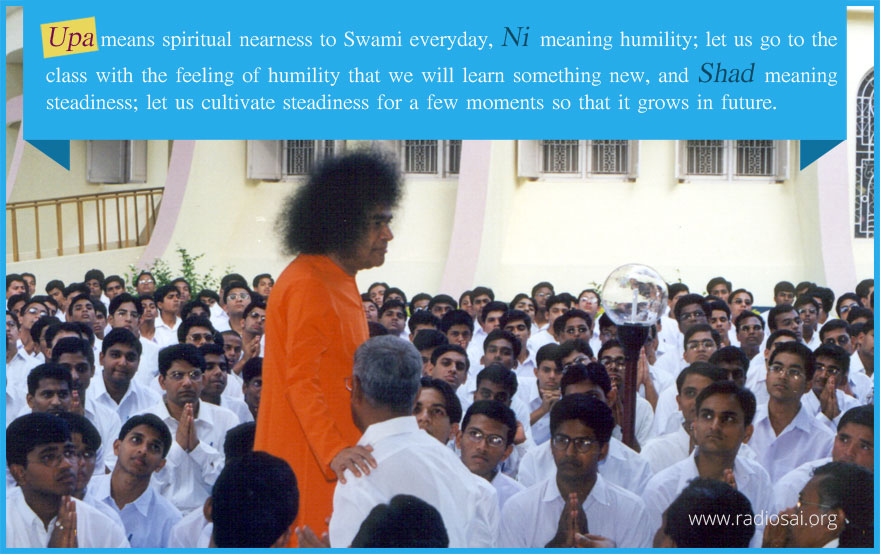 |
These are some of the important lessons of life that the Upanishads teach us. They also teach us several other spiritual truths, yet if we start with these simple lessons, we will grow into better individuals. I want to close my talk with this great quote from the Brihadaranyaka Upanishad which we chant everyday:
asato ma sad gamaya
tamaso ma jyotir gamaya
mrutyor ma amritam gamaya
From ignorance lead me to truth
From darkness lead me to light
From death lead me to immortality
I pray to Bhagawan that He blesses all of us with the strength and character to live up to His expectations so that we will be able to do our simple work in His grand mission.
- Radio Sai Team
What do you think about this article? Please let us know by writing to h2h@radiosai.org. Do not forget to mention your name and country.







